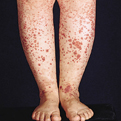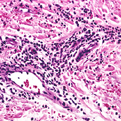Vasculitis
General Information
Vasculitis is a term used for inflammation of blood vessels in the skin. The inflammation is thought to arise through one or more of three main mechanisms; Direct injury to the vessel wall by virus or bacteria; Indirect injury by activation of antibodies; Indirect injury through activation of complement. Medications are known to be a common cause in the inflammation of the blood vessels and it will usually clear when it is not taken anymore. The most common medications include antibiotics, thiazide diuretics, thiouracil and oral anticoagulants. Once a patient is diagnosed and they are fully evaluated, specific or nonspecific options may be used. Elevation and resting of the affected limb or compression stockings may be useful. Urticaral lesions may be treated with antihistamines. Severe visceral involvement may require high doses of corticosteroids.
Epidemiology
Uncommon
Etiology
Unknown; Immune system abnormalities and inflammation of blood vessels are common features
Pathogenesis
Thickening, weakening, narrowing and scarring of blood vessels
Clinical
Palpable purpura usually round and ranging between 1 – 3 mm in diameter
Histology
Vascular and perivascular infiltration of polymorphonuclear leukocytes with formation of nuclear dust (leukocytoclasis
Bibliography
1. “Hypersensitivity Vasculitis (Leukocytoclastic Vasculitis” (Online). May 2007. http://www.emedicine.com/derm/TOPIC185.HTM (visited: April 4, 2008) 2. “Cutaneous vasculitis” (Online). March 2008. http://www.dermnetnz.org/vascular/vasculitis.html (visited: April 4, 2008)
Download PDF
![]() Vasculitis
Vasculitis


